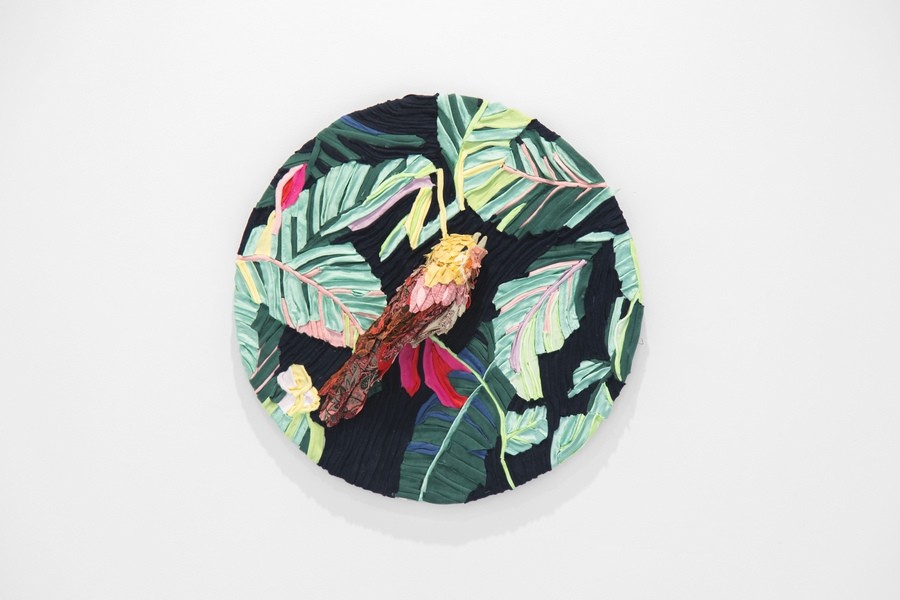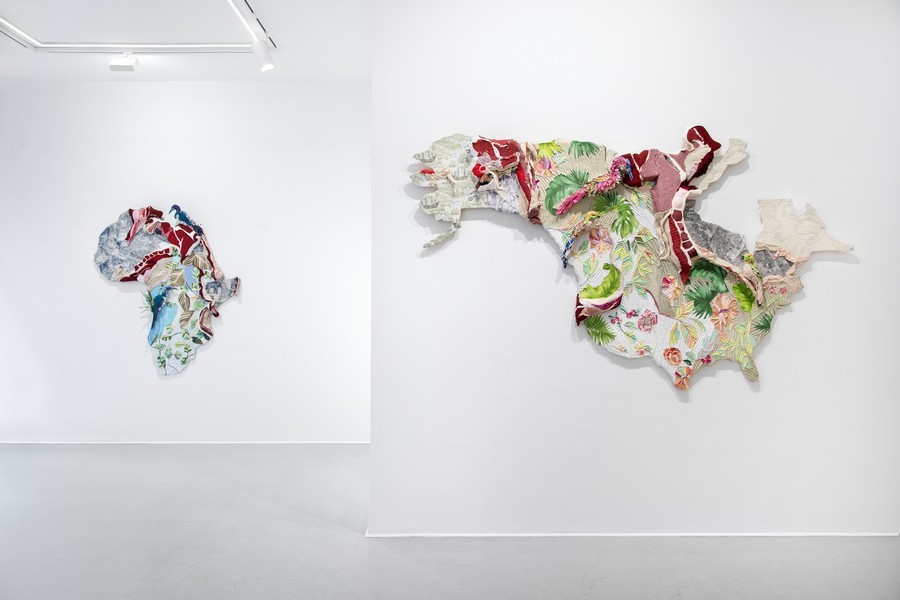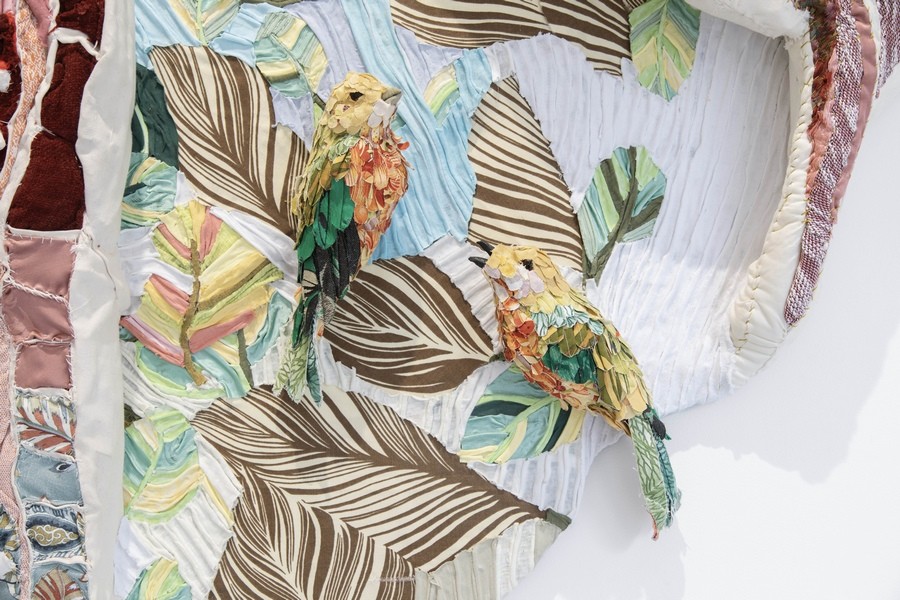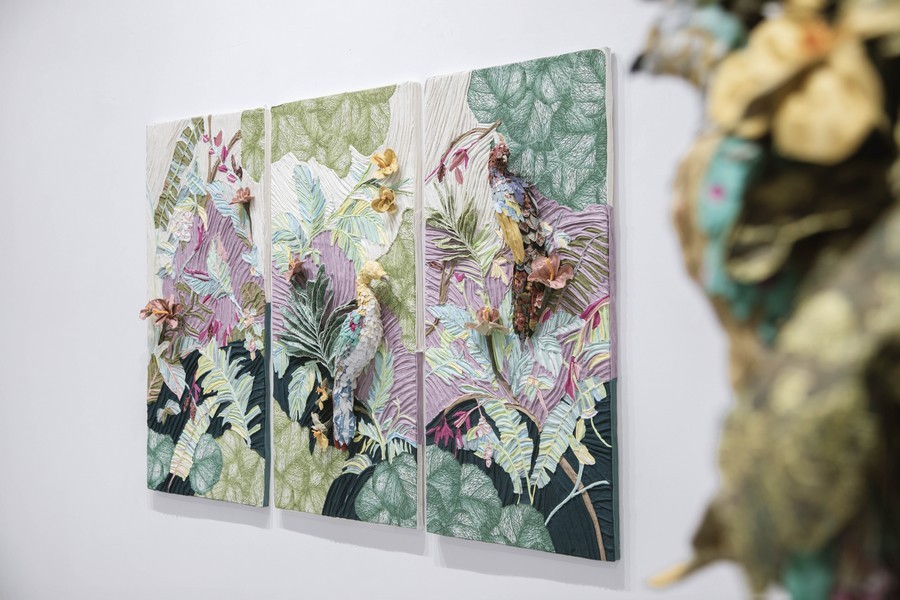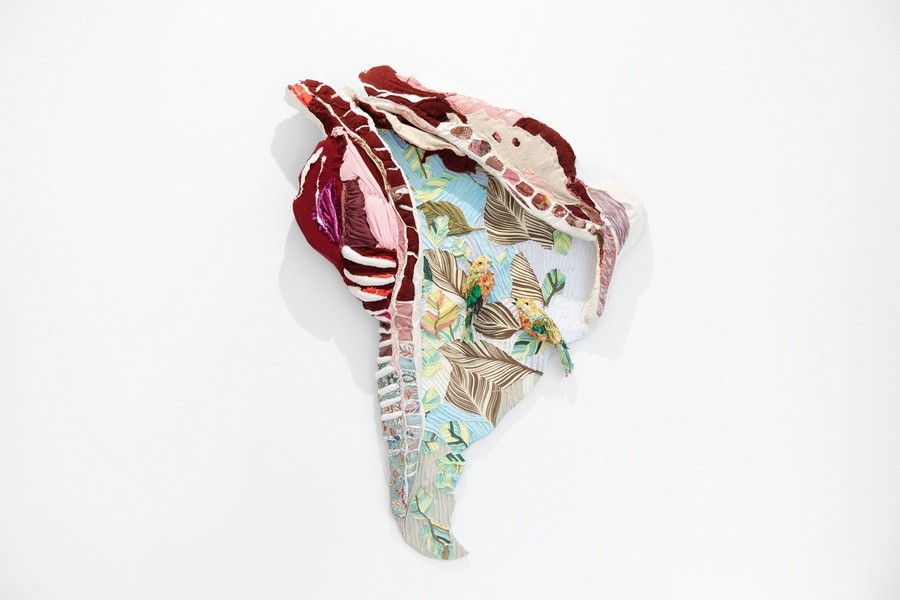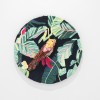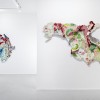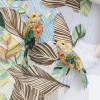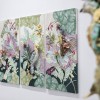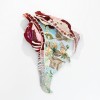For her second solo show at RX&SLAG Paris, Tamara Kostianovsky presents a dozen works created exclusively for this "Tropical Abattoir". The themes dear to her heart are violence, colonization, over-consumption and the environment. Alongside the animal carcasses that have made her famous, she presents a new series of three murals that she describes as "carnal geographies". Her works read like oxymorons, combining beauty and cruelty, subtlety and brutality, classicism and baroque.
We wander between imposing suspended animal carcasses, navigate inside geographical maps combining pieces of meat, birds and exotic vegetation, marvel at fragments of landscapes where colorful birds sing... Tamara Kostianovsky transforms the RX gallery into a "Tropical Abattoir" and draws us into her fascinating, raw and striking universe. Whether through her works or the title of the exhibition, she creates tension and keeps us on our toes with her delightful use of oxymoron. Like a tightrope walker, she strides along a ridge, striking a subtle balance between beauty and horror, refinement and brutality, renewal and putrefaction, life and death. Nothing about her work is innocent, and behind the invasive decorative motifs à la Matisse, she makes a clear-cut, unambiguous statement. She speaks to us of violence, colonization, over-consumption and the environment, always with relevance. "The series represents carcasses that transform into vegetation, becoming capsules that house exotic birds and plants. I think of these works in terms of metamorphosis. The idea is to change the image of the carcass from a place of carnage to a matrix where life takes root - in the manner of autopian environment." To achieve this, she designs her sculptures from clothing (one of the most polluting industries), her own or from other sources, but also from upholsterers' furnishing fabrics. She assembles them, sews them, superimposes layers, brings flesh to life, makes color shimmer. We're seduced.
Intimate violence
Her works are gut-wrenching, both literally and figuratively, as her carcasses give us visions of the insides of these torn-apart fabric animals. Art history flashes by, from Rembrandt's Flayed Ox to Artur Barrio, Adriana Varejao, Luis Jiménez, Goya and Latin American Baroque. These include the violence of intensive cattle farming in Argentina, the sutures of the plastic surgeries performed by her father, whom she knew well since she worked for a time in his practice, and the symbolism of Christ's sacrifice, an iconography that is omnipresent in her references despite the fact that she grew up in a Jewish family. Tamara Kostianovsky is familiar with a certain cruelty in spite of herself, starting with that of the military dictatorship in Argentina (1976-1983), where so many opponents disappeared in the ATACAMA desert, and more intimately, with the savage murder in 2004 of her grandmother, a Holocaust survivor. This episode is all the more abominable in that it remains unexplained and unpunished.
The migratory experience
Her maps and decorative panels deal with the question of migration, not only that which has marked history, but also that of her family (who left Europe in the 1950s) and her own: born in Jerusalem in 1974, she grew up in Buenos Aires until 2000, when she moved to the United States. She focuses on the main continents that have been colonized (Africa, North America and South America) and appropriates maps that have always had a political stake: the contours of the world are drawn to know it, to carve it up, to share it and to control its populations and wealth. His geographies become carnal. Her decorative panels also deal with colonization from another point of view. She has researched 18thcentury French wallpapers that depicted idealized, fantasized visions of the colonies, which gave rise to Orientalism. She interprets the motifs of lush vegetation and shimmering feathered birds while reminding us of the cruelty of the Spanish conquistadors, who went so far as to "set fire to the aviary of Moctezuma II (1502-1520), the last great Aztec emperor", she explains.
Tamara Kostianovky's works have a cathartic dimension, transmuting traumas into creative energy.
Interview with Tamara Kostianovky
Could you explain the choice of title for the exhibition, "Tropical Abattoir"?
I played on the idea of a surrealistic slaughterhouse where animal carcasses lose their tragic aspect to be transformed into regenerated tropical landscapes in full rebirth. There's a tension in the exhibition between beauty and ugliness, the decorative and the tragic, landscape and carnage, which is reflected in each of the works both conceptually and formally.
Could you introduce the exhibition?
For this second exhibition at Galerie RX, I'm very excited to present for the first time three wall works that combine maps with images of meat, in a new series I'm calling "Géographies charnelles", alluding to the carnal and violent history of nation-building. As such, you'll see a map of Africa, one of North America and one of South America, where geographies metamorphose into meat and vice versa. I have deliberately chosen colonized territories to evoke the way in which landscapes, flora, fauna and populations have been considered as goods to be exploited.
These works also reflect the intimate bond one develops with a homeland and how this embodiment can define one's identity. As a migrant from Argentina to the United States, I often wonder to what extent our place of birth defines who we are. In the exhibition, there are also three-dimensional carcasses overgrown with vegetation and housing exotic birds, or wall panels featuring birds from the Americas perched in landscapes inspired by 18th-century French wallpapers.
The French public discovered your work in 2022 with a group show at Galerie RX and in Deauville, at Les Franciscaines, with the "Arbres" exhibition. What links have you forged with France?
From a formal point of view, the influence of French decorative arts is reflected in my interest in French wallpapers from the historic Zuber factory. Rococo art has always had an influence on my work in the use of a color palette that juxtaposes pinks and greens, for example. Conceptually, there's also the link with animal slaughter and hunting culture, which is still very strong in France, and which is at the heart of my work.
In fact, I'm delighted to be presenting a solo exhibition at the Musée de la Chasse et la Nature in summer 2024. My installation will be in dialogue with the museum's permanent collection of historical paintings about nature, and my works recontextualized in this piece of art history will offer a point of view opposed to the narrative unfolding in the museum, where humans have perceived nature as external to themselves.
Your reliefs and sculptures evoke hunting trophies, animal carcasses and tree trunks. Do you see an analogy between animals and still lifes?
I taught art history for many years. I'm particularly drawn to the images of flesh that populate art history: Rembrandt, 17th-century Dutch still lifes, Goya, the Brazilian artists Artur Barrio and Adriana Varejao to name but a few. In my mind, these references inscribe my work in a tradition where artists have considered the flesh from both a conceptual and formal point of view. The body is the receptacle, the container and, at the same time, the bearer of the subject's identity. As my favorite French philosopher Merleau-Ponty explained, the body is the primary means/space for knowing the world.
Color plays an essential role in your work. Your works are shimmering and full of life, yet they speak of death and violence. Could you tell us about this opposition?
I don't consider animal remains and beauty to be contradictory. A dead body can be beautiful. Drama can be beautiful. Ultimately, beauty is what makes us feel something out of the ordinary. I navigate very carefully on the border between the abject and the colorful, and I discover beauty precisely in that interstice where they meet.
Do your works have a cathartic role in relation to the violence of the world?
My work reflects on the architecture of violence, which includes violence against animals, trees, people and all living beings. I focus on feminicide and gender-based violence, which I make evident by using women's clothing as my main material. Growing up in Argentina influenced the kind of imagery I was drawn to, where ox carcasses are ubiquitous and linked to collective pride and national identity. For me, the carcass refers to the violated body, and I also associate it with criminality and the history of military dictatorship. It's not necessarily specific to animal cruelty. That said, over the years I've become increasingly aware of industrial agriculture and the negative effects it has on the environment in general. My most recent work deals with ecological issues, proposing a kind of utopian renewal.
Is recycling clothes a way of taking care of the world?
One of the aims I have with my work is to change the preconceived idea that waste is a substance to be eliminated from the Earth, by presenting discarded textiles as a malleable material in permanent circulation with multiple possibilities for application in art, design, construction and many other industries. With my work, I aim to reach a wide audience, composed mainly of young art lovers, craft enthusiasts, architects and designers, as well as museum visitors and fashion aficionados of all ages who are currently turning to fast fashion but may be awakening to "upcycling" as a political and environmental movement.
Can you describe your creative process? Do you start with a preparatory drawing?
From time to time, images come to mind and I rush to get them down on paper. I have a big binder with images of carcasses that I'm constantly drawing. I usually have an idea of what I want to do, but things change and adapt as I go along. It takes me about two months to create each piece. Some weeks I let the sculptures "rest" and simply observe them while I work on something else, until I find a solution to a formal problem or realize that the work is finished and needs nothing else. But it's more often the first situation. I could describe my work as a succession of stages, a time-consuming process of refinement that requires going back and forth, a multiplication of steps to adjust, accentuate a diagonal, smooth out an overly marked contrast....
I draw my materials from my own and my son's closets, and buy scraps of upholstery fabric. Sometimes I receive donations from close friends. It's important for me to have a link with the materials I handle in the studio.
